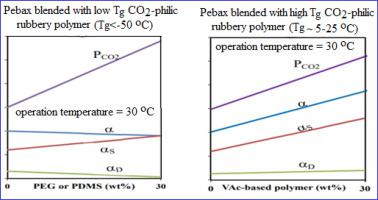Reactive & Functional Polymers ( IF 5.1 ) Pub Date : 2020-06-14 , DOI: 10.1016/j.reactfunctpolym.2020.104673 Marzieh Shirinia , Mahdi Abdollahi , Mohammadreza Omidkhah

|
In this work, blend membranes based on poly(ethylene oxide-b-amide 6), i.e. Pebax 1657, and 30 wt% of dense, rubbery and CO2-philic vinyl acetate/ dibutyl maleate (VAc/DBM) copolymers with different chemical compositions were prepared. Depending on the copolymer composition, glass transition temperature (Tg) of copolymers were measured to be in the range of 7–23 °C. Copolymer composition dependency of the copolymers' density was also evaluated. Interaction of the various components present in as well as morphology of the blend membranes were investigated by Fourier transform infrared spectroscopy (FTIR), differential scanning calorimeter (DSC) and field emission scanning electron microscopy (FE-SEM) analyses. The permeability of CO2, CH4 and N2 gases was determined at a pressure of 3–9 bar and a temperature higher than Tg of CO2-philic VAc/DBM copolymers, i.e. 30 °C. Although copolymers had densities higher than that of pristine Pebax 1657; however, CO2 diffusion increased by adding these copolymers. It can be attributed to the increased volume fraction of amorphous portion in the blend membranes, which is responsible for gas transport, as well as to enhanced mobility of polymer chains. CO2 permeability and CO2/CH4 and CO2/N2 selectivities were found to increase simultaneously in all of the blend membranes in comparison with the pristine Pebax 1657. It may be attributed to enhanced CO2-philicity of the blend membranes, resulting in the enhanced CO2/CH4 (or N2) solubility selectivity, as well as to the enhanced fractional free volume in the blend membranes with free volume sizes suitable for transport of smaller molecules of CO2, resulting in the enhanced CO2/CH4 (or N2) diffusivity selectivity. The best results were found for a blend membrane containing 30 wt% VAc/DBM copolymer with 72 mol% VAc in the chains, where CO2 permeability and CO2/CH4 and CO2/N2 selectivities increased about 198%, 157% and 156%, respectively, compared to the pristine Pebax. Both CO2 permeability and selectivity increased by increasing pressure in the range of 3–9 bar, while plasticization phenomenon was not observed, indicating that the blend membranes prepared in the present work can practically be used for efficient separation of CO2 from the mixed gases.
中文翻译:

通过将致密的,橡胶状的和亲CO 2醋酸乙烯酯基共聚物掺入聚环氧乙烷-b-酰胺6膜中,同时提高CO 2的渗透性和CO 2 / CH 4以及CO 2 / N 2的选择性
在这项工作中,共混膜是基于聚环氧乙烷-b-酰胺6(即Pebax 1657)和30 wt%的稠密,橡胶状和CO 2-亲和性醋酸乙烯酯/马来酸二丁酯(VAc / DBM)共聚物制备了组合物。根据共聚物的组成,测得共聚物的玻璃化转变温度(T g)为7-23°C。还评估了共聚物组成对共聚物密度的依赖性。通过傅立叶变换红外光谱(FTIR),差示扫描量热仪(DSC)和场发射扫描电子显微镜(FE-SEM)分析研究了共混膜中存在的各种成分之间的相互作用以及形态。CO 2,CH 4的渗透性N 2气体是在3–9 bar的压力和高于T 2的亲CO 2 VAc / DBM共聚物的温度T g下确定的,即30°C。尽管共聚物的密度高于原始的Pebax 1657的密度。然而,通过添加这些共聚物,CO 2扩散增加。这可以归因于共混膜中无定形部分的体积分数增加,这导致气体传输,以及聚合物链的迁移率提高。CO 2渗透率和CO 2 / CH 4和CO 2 / N 2与原始Pebax 1657相比,发现所有混合膜的选择性均同时提高。这可能归因于混合膜对CO 2的亲和性增强,导致CO 2 / CH 4(或N 2)溶解度增强选择性,以及具有适合于运输较小分子CO 2的自由体积大小的共混膜中增加的分数自由体积,导致提高的CO 2 / CH 4(或N 2)扩散选择性。最好的结果,发现对于含有30重量%的醋酸乙烯酯/ DBM共聚物与72%(摩尔)醋酸乙烯的链,其中一个CO共混膜2与原始Pebax相比,渗透率和CO 2 / CH 4和CO 2 / N 2选择性分别增加了约198%,157%和156%。通过在3–9 bar的范围内增加压力,CO 2的渗透性和选择性都增加了,而未观察到增塑现象,这表明本工作中制备的共混膜实际上可用于有效地从混合气体中分离出CO 2。 。


























 京公网安备 11010802027423号
京公网安备 11010802027423号